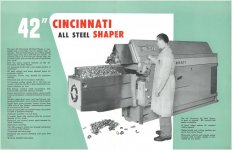ES Butler:
Thank you for posting the Cincinnati shaper brochure. Reading through it, I got all my questions answered. Cincinnati did use a welded steel frame, fully stress relieved. The ram was spec'd as Corten steel. My only familiarity with Corten was for outdoor structural applications. Corten is mainly used as a "weathering" steel in that it develops a layer of surface rust, and then no further corrosion occurs. I will have to read up on Corten to find out what the advantage was in using it for the ram on this shaper.
The drive for the ram is quite interesting. Where I had thought Cincinnati used hydraulics, they use a power feed screw and bronze nut, screw being nitralloy steel to get a high surface hardness. A gear transmission is used to change ram speed, but a constant speed (and quite rapid) return stroke is mentioned, as are the types of clutches used in the transmission.
The machine, if it ever was built and put into use in working shops, had to have been an absolute bear. In the days before programmable VFD drives, I wonder how (or if) Cincinnati had any sort of controlled acceleration and deceleration for the ram on the return stroke, or whether the clutches were simply "feathered" automatically.
More intriguing is Cincinnati's statement that energy is recovered on the return stroke. How this was accomplished on a screw feed ram would be quite an interesting piece of design. Possibly, the ram feed screw had multiple leads, so force applied to the nut might turn the screw instead of the other way round. With that idea, maybe Cincinnati used some sort of regenerative braking. However, they give a "recommended" motor size of 20 HP, and no mention of any specific electrical requirements, so the idea of regenerative braking may be wild thinking on my part.
However, if Cincinnati Shaper was the same Cincinnati who built the "Hypro" planers, they would be no strangers to reversible motor drives and circuitry to electrically decelerate a planer table. The "Hypro" planers used a DC motor drive, while this shaper used a 20 HP 1800 rpm motor- with voltage and phase determined by the purchaser's on-site power. On that same vein, Cincinnati Shaper, whether they also built the Hypro planers or not, likely had little or no experience with hydraulic power for shaper rams. This may be why they went with the geared screw drive for the ram. In my opinion, making a geared screw drive and the transmission to drive it, seems like a lot more work than using standardized industrial hydraulics. Rockford used Vickers hydraulics for their shapers and planers, and changing cutting speed is a matter of turning a knurled knob on a metering valve. Ends of strokes and decelerating the ram is taken care of by cushioning valves and orifices, and setting stroke length is a matter of moving trippers along the side of the ram. By the time Cincinnati was marketing this all-steel shaper, industrial hydraulic were a well developed thing. Why Cincinnati went about driving and returning the ram in what would seem to be a more difficult method is another one of those questions we will never know. Possibly, aside from their wanting to stick with what they knew, Vickers may have had some sort of exclusive agreement with Rockford whereby they could not design and furnish hydraulic drives to competing machine tool builders.
As the saying goes, things get "curiouser and curiouser", having read through the brochure.






